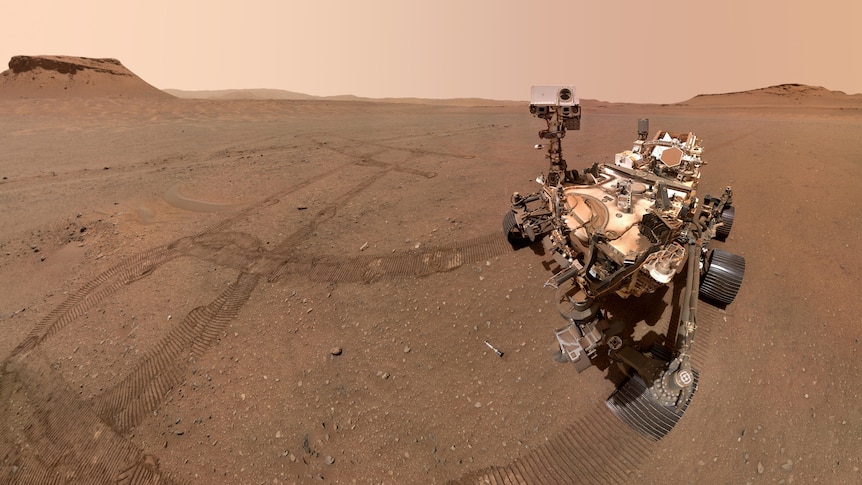
Science
Artificial intelligence could help identify life on Mars and settle debates about life on Earth: study
For the past two decades, a 3.5-billion-year-old rock sample discovered in the Pilbara, in Western Australia, has divided the scientific world.
Initial analysis of the rocky deposit, known as the Apex chert, suggested it contained evidence of the oldest life on Earth: microfossils from long-dead microbes.
Further research suggested the chert contained minerals, not evidence of ancient life. Today, the sample's origins are uncertain and remain hotly debated.
Now scientists hope an approach using AI might help settle this debate and, more importantly, help us look for life on Mars and beyond too.
A team led by Bob Hazen, a mineralogist at the Carnegie Institution's Geophysical Laboratory, report their findings today in the journal Proceedings of the National Academy of Sciences.
"Our method suggests that we may already have the kind of tools needed to answer the greatest of questions: Are we alone?" he said.
Using machine learning, a form of AI, the team show their technique can differentiate between biotic samples, those originating from life, and those which are abiotic, or arise from mechanisms devoid of life.
"They're looking for the Holy Grail of astrobiology," said Martin van Kranendonk, professor of geology at the University of New South Wales, who was not affiliated with the study.
"I'm very excited by the potential."
When searching for signs of ancient life on Earth or other planets in the Solar System, scientists look for biosignatures – molecules or markers we know are associated with life.
For example, if they discovered DNA on Mars, that could be a strong indicator that life once existed there.
The new method takes a much broader approach. Professor Hazen says it arose out of his convictions that the chemistry of life will look inherently different to the chemistry of non-life.
"We're not looking for an amino acid, we're not looking for DNA," Professor Hazen said.
"What we're looking at is a much more fundamental difference in the distribution of molecules and the patterns of molecules."
To find these patterns, the team examined a collection of 134 carbon-bearing (or "organic") samples using a technique known as pyrolysis gas-chromatography mass-spectrometry (GCMS).
They looked at 59 samples of biological origin including things such as human hair, a grain of rice, pumpkin seeds, bacteria, plants and grass.
Scientists are on a quest to find out if another planet other than our own ever hosted life. Clues to what they might find are hidden in the ancient landscapes of Australia.
The other 74 samples were abiotic. Many of them were chemicals synthesised in a laboratory and a few were carbon-rich meteorites collected on Earth.
Each sample was subjected to high temperatures, helping break it down to its constituent molecules and enabling the team to identify the size and charge of those molecules and how they change over time.
This technique spits out an incredible amount of data – some 500,000 data points for every sample. Lurking somewhere in all that data are patterns, but they're much too complex for humans to pull apart.
That's where the AI comes in.
The research team expected the AI would sort their 134 samples into two distinct groups: living or non-living.
But, Professor Hazen said, the AI surprised and delighted the team, separating the samples into three: non-living, recently alive and alive in the ancient past.
They tested the model thousands of times and found AI was able to predict which category each sample fitted into, with around 90 per cent accuracy.
Want more science — plus health, environment, tech and more? Subscribe to our channel.
Of course, that leaves a one-in-10 chance it gets things wrong, too.
Even so, Professor Hazen has been presenting the findings at scientific conferences and said the early reactions were positive. Scientists have been lining up to have their samples assessed.
Professor van Kranendonk, for instance, has already sent samples to Professor Hazen's team for analysis – as have researchers from China, India and Canada.
Professor Hazen hopes to analyse these samples within the next year.
If the method is as robust as it appears, there's also the possibility it could help put to rest some of the disagreements around the Apex chert.
Running the analysis on fragments of that rock is something Professor Hazen would like to do.
"I want to be able to resolve that in some way," he said.
The applications beyond Earth are, potentially, even more profound.
NASA's Perseverance rover is currently rolling around an ancient lake bed on Mars, drilling into rocks and storing samples for return to Earth in the next decade.
How would we know if it discovered life? How would we differentiate the findings from a geological feature?
The new method presents a potential way to do so. Because it relies on detecting patterns, it might discover a molecular pattern completely unlike anything we've seen on Earth.
Such a discovery could hint at alien biochemistry – although it wouldn't confirm the existence of alien life.
"If we found such an anomaly, then a lot of follow-up experiments and analysis would be needed," Professor Hazen said.
David Flannery, a planetary scientist from the Queensland University of Technology and a principal investigator on the Perseverance mission, sees the study as incremental progress on a difficult problem.
He noted the machine learning technique was not a "one-stop solution" for discovering life outside of Earth, but it could be another useful tool in the toolkit.
"We're probably going to need to get samples back into our labs on Earth and apply lots of different techniques," he said.
Professor Hazen agrees there is still a lot of work to do.
"We are forging ahead with many more samples, alternative machine learning approaches, and multiple runs to improve the method," he said.
He also hopes other scientists will take notice of the paper, looking at the problem in their own way and helping cross check and validate the model.
"Maybe, if it's wrong, we'll find out," he said.
"But if it's right, then it opens doors, and those doors are very tempting."
We acknowledge Aboriginal and Torres Strait Islander peoples as the First Australians and Traditional Custodians of the lands where we live, learn, and work.
This service may include material from Agence France-Presse (AFP), APTN, Reuters, AAP, CNN and the BBC World Service which is copyright and cannot be reproduced.
AEST = Australian Eastern Standard Time which is 10 hours ahead of GMT (Greenwich Mean Time)
